Knowing photosynthesis thanks to short laser pulses

With a system that emits very short laser pulses, they have managed to study in more detail the movement of electrons that occurs during photosynthesis. Specifically, researchers from the University School of Dublin and the Imperial College of London have studied the movement of electrons produced in the LH2 protein involved in photosynthesis.
One of the functions of the protein LH2 is to break the water molecules and release the electrons from these molecules to participate in the transport of electrons that takes place during photosynthesis and that finally generate the energy necessary to transform the carbon dioxide into sugar.
The scientists knew that this transport of electrons is produced, but they did not know how electrons interact with the molecules involved in photosynthesis. In fact, the laser techniques used so far transformed or destroyed the proteins of photosynthesis, since they are very sensitive.
The aforementioned researchers have used laser pulses of only 100 femtoseconds of duration. These pulses have been enough to detect interactions within the LH2 protein, but too short to transform the protein.
Buletina
Bidali zure helbide elektronikoa eta jaso asteroko buletina zure sarrera-ontzian











